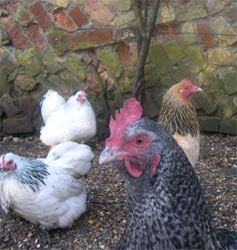Carol (the chicken)
Posted by Fiona Nevile in Chickens | 6 comments Carol, our Maran hen started laying again on Saturday. Large brown eggs with deep orange yolks. I have a soft spot for her. She is the first hen that we raised from an egg. Carol is special.
Carol, our Maran hen started laying again on Saturday. Large brown eggs with deep orange yolks. I have a soft spot for her. She is the first hen that we raised from an egg. Carol is special.
We were happy with our hens until Thumper, a ginger layer, became broody. I was working locally at my friend Carol’s house and bemoaned my fate. I’d tried shifting the hen off the nest every few hours but she would stalk back up to the nesting box and settle again immediately. At this early stage in my chicken keeping experience, I didn’t know how to stop a hen being broody (this information is in my post Mrs Boss is broody.)
A few hours later, Carol (the human) came into the kitchen with three freshly laid fertilised eggs.
“Why not have a go at breeding? Put these under your broody hen and see what happens.”
The eggs were large and brown and tantalising.
“But what about Danny?” He was away at the time and might disagree.
Carol was enthusiastic. “Danny will love it. If he doesn’t, I’ll have the brood back.”
Carol knows her stuff. She’s hatched pheasant eggs on her Aga in the past.
Fertilised hens’ eggs are in suspended animation until they are incubated. The incubation temperature is 37? to 38 ?c. Prior to incubation they can be moved and even sent through the post. I had always wanted to see a chick emerge from an egg, so I took the clutch. One of the eggs had a very thin shell and broke on the journey home. I popped the other two under Thumper. Her breast feathers were soft and gorgeously warm. We had 21 days to wait until the chicks would hatch. Then I rang Danny. Luckily he was indulgent and permission was granted. He had no idea that the eggs were already in situ.
The eggs cannot be allowed to get cold once the incubation process has started. The hen will get off the nest every now and then to stretch her legs but she needs to have food and water by the nest as her instinct is to sit tight. I moved the hen and eggs to their own apartment away from the rest of the flock. By the 21st day I was in a fever of excited anticiptation.
Carol hatched on my friend’s birthday so just had to be christened Carol. Seeing the shell and the tiny energetic chick was very moving. Sadly the other chick didn’t make it. Within hours, Thumper was teaching Carol to drink and scratch, a round fluffy ball that alternated between running away and hiding under Thumper’s wing. Hen and chick settled each night much earlier than the rest of the flock at around five pm. Thumper was exhausted.
Chicks are vulnerable, despite being guarded by the mother hen. The hen and chicks need to be kept seperate from the flock for the first few weeks. Then they can be let out to mix during the day but will naturally return to their sepearate space to roost at night. The pullets are usually big enough to stand up for themselves at three months. They are a target for bullying, being the youngest in the flock.
Carol grew rapidly, with a dark grey-black colouring. Marans are large hens so she was soon the same size as Thumper. A plain, gawky, vulture-like creature. I watched her first joyful swooping flight onto the roof of the hen house and then her terror at the prospect of the journey back. When her adventures got her into trouble she would shriek and wail until Thumper arrived to help her out. One evening, after about three months, I was alerted by an extended squawky wail coming from inside the hen house. I shot down to the pen. I had forgotten to open the door to Thumper and Carol’s maternity apartment so they had gone into the main house to roost. It was Carol’s first night in the big girls’ dormitory. She was balanced on the perch, shrieking. Big though Carol was, Thumper was right beside her and had put a wing over her back to comfort her. It was a touching, unforgettable moment.
Leave a reply






Fiona, you asked us to get back, so, here goes. Bad luck really – none of the 13 eggs hatched, although when I checked them most were some way on and several had embryos up to about 10 days old. I think that the large amount of eggs meant that at least two were always ‘outside’ and got cold – eventually all of them went the journey.
Afterwards, she wouldn’t accept the fact that she
had no egss and, as she had been sat for over a month, I built and used the un-broody coop – it worked well.
Lessons learnt from this? You will remember, we were so excited that we let her sit on the (8) eggs in the ark but the others were going in and laying when she was eating and going to the loo – by the time we realised this, she was sitting on 13 eggs (and she is not very big) and as we didn’t know which were which, we let her sit on 13 eggs – a bad decision in hindsight. So, in the future, as soon as she is broody, we’ll put her in the broody coop with 6 eggs at the most. Give her 24 days maximum and turf her out. Hopefully that will do the trick
Thanks for the help – excellent – we’ll keep in touch, especially if we do get some chicks.
Cal and Jane
Hello Cal and Jane
I’m not sure of the gestation period for Mechelense Koekoek. Sometimes a clutch of eggs can hatch late or over a period of a few days.
You could try candling the eggs to see if they are fertile. It might be worth asking in the Sunday market about gestation periods. Once you are certain that the eggs are not going to hatch (either infertile or way past the expected hatching period – at least a week) you need to remove the eggs and move her to an anti broody coop. There are instructions for making one here http://www.cottagesmallholder.com/?p=289
I’d be really interested to hear how this turns out.
Great to hear that you are finding the site useful.
Fiona, we have only just found your site (whilst looking for info on what to do with our broody hen) and think it is great. We have had layers for about 8 years both in the UK and now, out here in Belgium. Our plan has always to have a smallholding (chickens, ducks, pigs, dexter cattle and bees, so the site struck a cord)
As soon as we got to Belgium (July 07), and having given our layers to a friend with lots of land – and chickens, in Surrey, we went looking for a local breed and found some Mechelense Koekoes (our local town is Mechelen), which are barred and look like a cross between an ostrich and a cuckoos (they are huge). We wanted 5 ladies and 1 cockerel – to cut a long story short, some time later, wondering why we hadn’t got any eggs, we went away for a week; when we returned, all of them were crowing!!!
Anyway, out here in Belgium, the people are not as squeamish or as stupidly H&S-obsessed as the british, so we went to the local Sunday market, where they have a choice of about 300 birds of all different types and got some ‘layers’, expecting them to be just that (i.e. not broody). We currently have 9 ladies and 2 roosters (which are twice the size of the girls) and normally get 6-7 eggs a day.
Again, we recently went away for a week and when we came back, one had gone broody and was sitting on 9 eggs; we couldn’t get near her (pecking and squawking) and weren’t sure what to do so, after a few days, went looking on the internet and found your site – wonderful.
When we moved her to a broody coop, she had 13 eggs! Obvuiously, the others had been sneaking in and laying, during her ‘time off’. Meanwhile(just as you said) no other eggs were being laid – After we moved her the others went back to normal laying and all is well … except that we are now at 22 days since we found her on the pot – what do we do if we get to 23, 24 .. etc days? Do we just take the eggs out one-at-a-time, or simply de-brood her (lock her out, ice cubes, wire-mesh under etc etc). She can’t sit there for ever.
Grateful for any advice you or others might have.
Cal and Jane
Hi Pauline
I would try and clean her up a bit before you move her as the poo might foul the eggs. A sponge is very useful here. She won’t like it but wet the area and leave for a few minutes, feed her some corn or wild birdseed to distract her. Then remove as much as you can.
Some people move chickens after dark as they are wuzzy and easy to move. A broody hen is also wuzzy, 24/7.
I moved Thumper out of the nesting box and as she ate and drank I quickly shifted the eggs into her new nest in the ark. Then I picked her up. Hands over her wings. And placed her gently on the eggs. She settled in an instant.
If your hen has a pooey bum it might be wise to turf her off the nest morning and evening, she will suddenly drop her broody trance, relieve herself and return to the nest. Make sure that she has food and water within reach of her nest. Mrs Boss only feeds when I turf her off the nest when she is broody so the morning and evening routine is vital.
I’d love to hear how you get on!
Hi, thanks for info. I have broody which is sitting on 6 eggs (donated) since Friday (3 days)but is still in henhouse. She ventured out for the first time today and her rear is quite mucky. Should I give here a wash or is she best left. She only has 1 other companion at the moment. How did you manage to move Thumper & eggs? and is there a chance she may stop sitting?
As you can tell this is all new to me. Thanks
I met Carol recently, she is amazing. I love her. She passed me an egg.